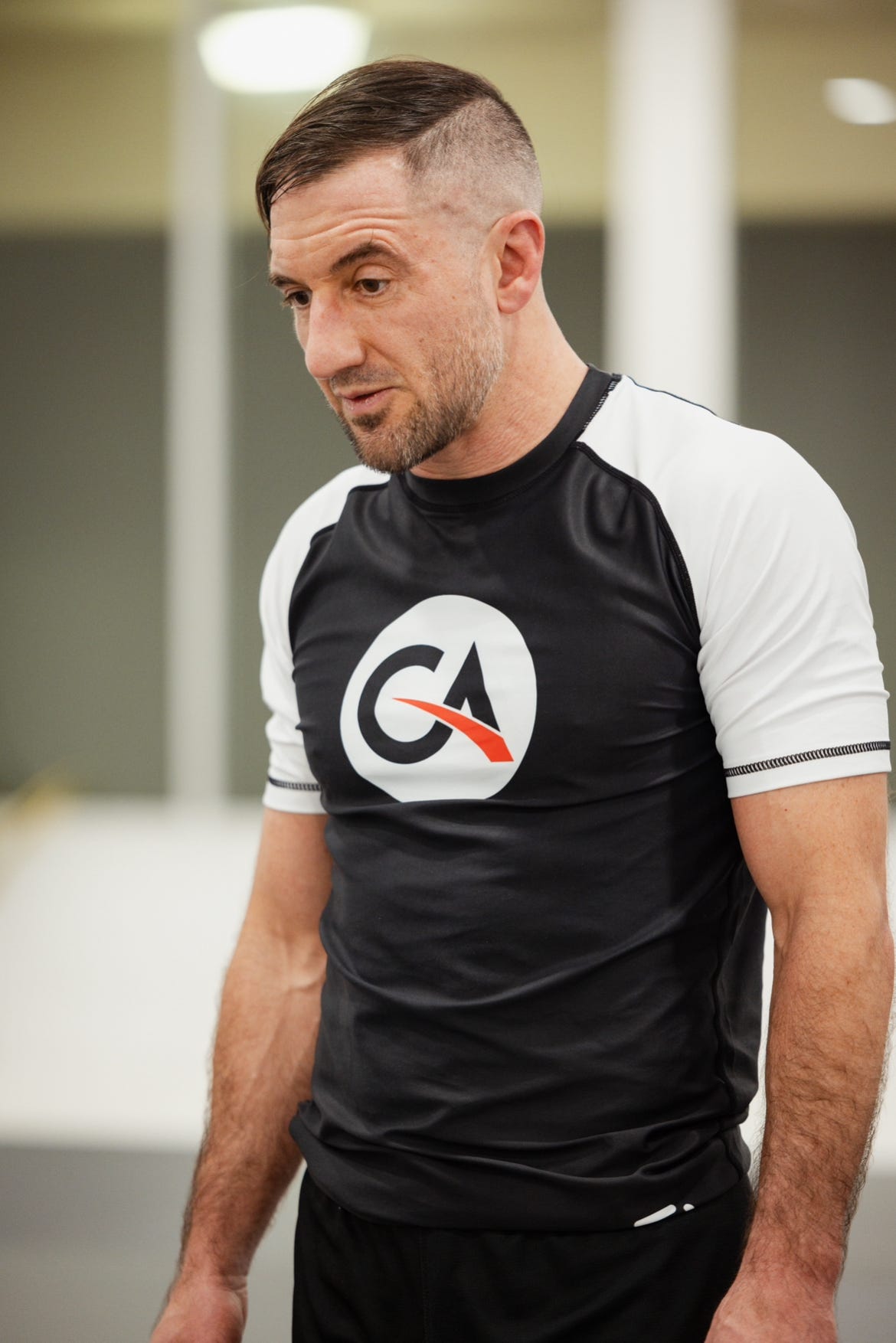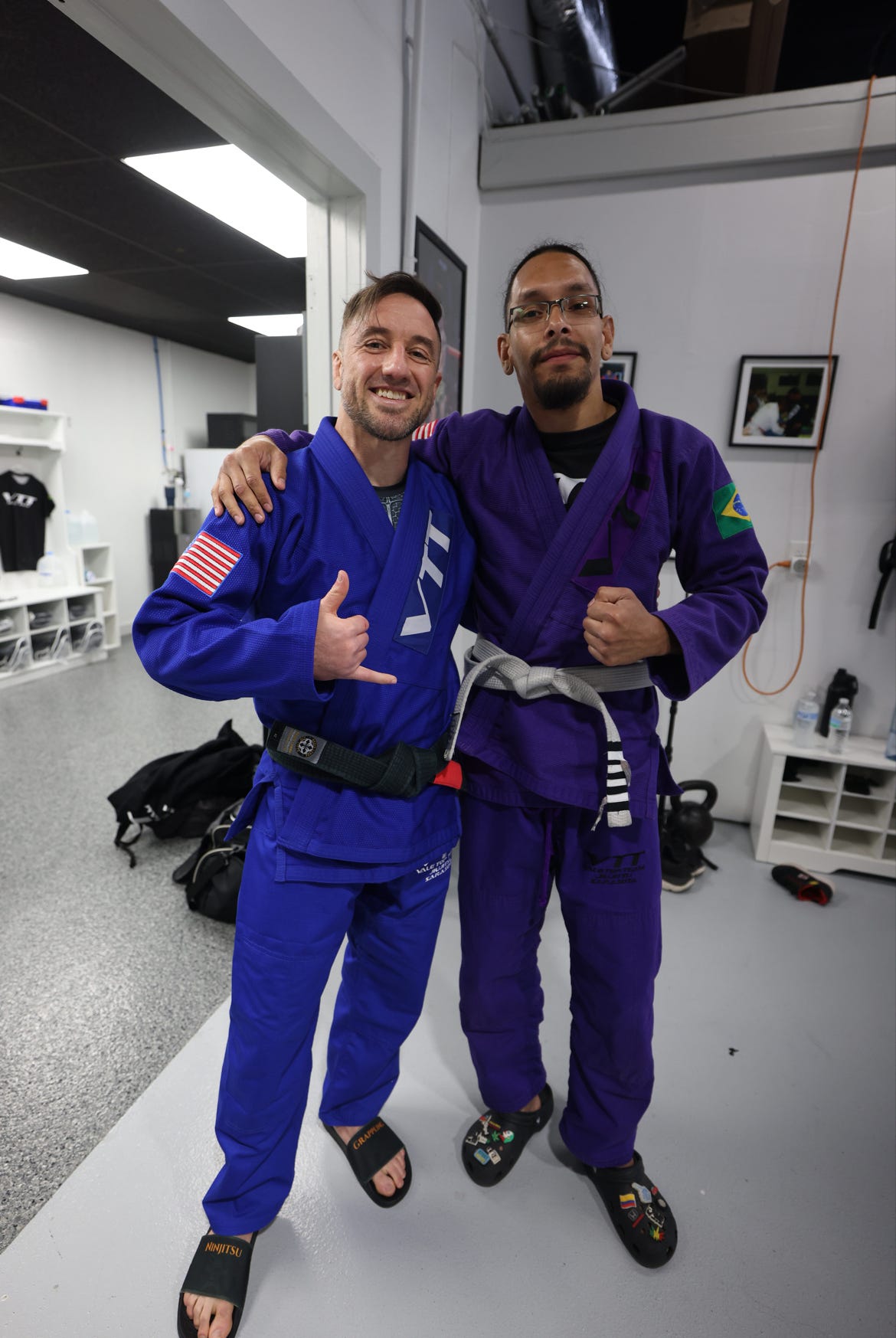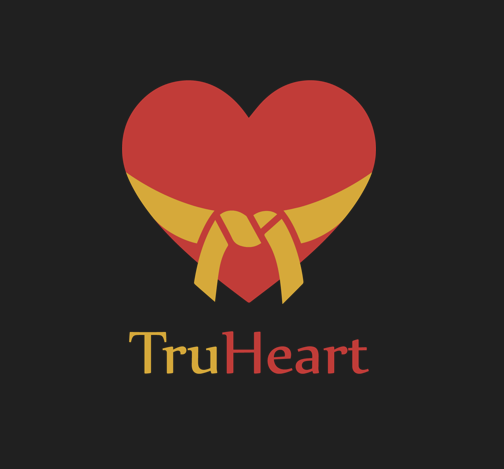Beyond the Mat
What Makes a Champion in Jiu Jitsu and in Life
The mat doesn't lie. Blood and sweat leave honest signatures. Every submission tells a truth about who you are when comfortable masks fall away.
I've lived this revelation—from trembling as a 75-pound eighth-grader to standing atop world championship podiums. My path curved through addiction's darkness, wandered through valleys of doubt, and sometimes lost sight of mountains I one day swore to climb.
But un-walked trails often lead to undiscovered territory.
Before we begin: What if I said, transformation isn't what you expect? What if the path to becoming a champion looks nothing like the stories you've been told?
The White Belt Mindset: The Courage to Begin
Every martial artist remembers their first day on the mat. The unfamiliar terminology, the awkwardness of new movements, the vulnerability of not knowing. This initial discomfort is unavoidable yet…essential.
In Jiu Jitsu, as in life, the greatest obstacle isn't the opponent across from you. It's the voice inside that whispers you don't belong, you’re not good enough, quit now.
My wrestling coach taught me this first lesson when I was that 75-pound eighth-grader, paralyzed by the fear of judgment. On the mat, there was nowhere to hide from anyone, not even myself. Each match forced me to confront that fear directly – to feel it fully while moving forward anyway.
Fear has its own heartbeat. It drums against your ribs, steals your breath, and narrows your world to tunnel vision. Muscles can coil like springs awaiting release. Ancient as the reptile brain, yet fear can be familiar as your own name. But the warrior's art isn't fearlessness—it's recognition without surrender, acknowledgment without obedience.
What was the last thing that made your heart pound with fear? Did it inspire courage or greater fear? Is it unresolved – or did you find proof of your strength in that moment?
In wrestling, the proper stance—knees bent, head up, hands ready—presents minimal opportunity to your opponent. However, the wisdom reflects deeper than technique: you create angles your opponent can’t attack easily. This is mental as much as physical. Acknowledge fear without squaring up to it directly. Keep your center of gravity defended. Shoot for the single-leg when fear least expects it, driving through at an angle it can’t sprawl against.
My early wrestling matches were far from graceful. I lost far more than I won. But with each return to the mat, I was developing a neural pathway that would serve me forever: the ability to act despite discomfort.
This is the white belt wisdom: beginning requires no special talent, only the willingness to look foolish in service of growth. Two state championships and an All-American title later, I had my first proof that transformation was possible when we act despite our fear.
Micro-Practice: Name your fear aloud before stepping up to your next challenge. The samurai knew that naming demons diminishes their power. One word spoken in truth can silence a thousand whispers of doubt.
What separates champions from spectators isn't innate talent or fearlessness. It's simply their willingness to step onto the mat repeatedly, especially when they don't feel ready.
What challenge are you hesitating to step up to right now?
The Blue Belt Challenge: Finding Balance in Chaos
The blue belt stage in Jiu Jitsu is notorious for drop-outs. The initial excitement fades, progress seems to plateau, and the path forward becomes less clear. This mirrors my experience at Drexel University, where I transformed from an electrical/computer engineering student into a dropout and blackout drunk.
I had become what I feared most – a reflection of generational patterns I promised I'd never repeat.
In Japanese martial arts culture, we call this stage munen-muso – the valley of confusion. The basics no longer satisfy, but the advanced techniques remain out of reach. This is where we discover that sustainable progress isn't about constant forward momentum; it's about finding equilibrium amidst uncertainty.
Think about standing on one foot. Notice how your body makes hundreds of micro-adjustments per second. Balance isn't static – it's a dynamic process of continuous recalibration.
Enter my Northern Shaolin Shifu, Har Ming Lau, who showed me that chaos isn't something to escape – it's a natural force we must learn to balance. The techniques themselves were less important than the principle they embodied: finding center when everything around you is spinning.
In Northern Shaolin, the stance ma bu (horse stance) builds not just physical but mental stability. With your feet wider than shoulder-width, knees bent, and back straight, you create a foundation that's difficult to topple. When I practiced this stance for hours during my early sobriety, I wasn't just training my quadriceps – I was rewiring my response to discomfort. Shout out to my friend Kyle Shepard who writes the Substack Publication called “Resilient Mental State”.
In Jiu Jitsu, champions aren't those who avoid difficult positions; they're the ones who remain composed within them.
Consider what happens when you're caught in a submission hold. The untrained instinct is to panic and use explosive strength to escape. But seasoned practitioners know that tension only accelerates defeat. Instead, they breathe, create space millimeter by millimeter, and maintain clarity even as pressure mounts.
Through sobriety and martial arts training, I discovered the essential truth: the problem I thought I had wasn't actually the problem – which is why it had been so hard to solve. My drinking wasn't the primary issue; it was a symptom of my inability to maintain equilibrium when faced with life's natural chaos.
When the waters rise around you, do you thrash or find stillness? Champions know that panic will drown you faster than any current.
The blue belt teaches us that strength isn't about dominating chaos; it's about dancing with it. This requires a fundamentally different relationship with discomfort – not as something to numb or avoid, but as valuable information guiding us toward balance.
Micro-Practice: Find your ma bu – your horse stance – when chaos storms around you. Remember the oak doesn't battle the wind; it simply remembers its nature. It roots below while its branches reach toward the sky.
Have you been trying to eliminate chaos from your life, rather than developing the capacity to remain centered within it?
The Purple Belt Perspective: The Power of Humility
After 12 years as an inconsistent white belt in Jiu Jitsu, I had to face a humbling truth – I needed to begin again with beginner's mind.
In Japanese martial arts, this concept is called shoshin – the fresh perspective that allows even masters to see old techniques with new eyes. It's the recognition that expertise can become a barrier to growth when it hardens into certainty.
This realization led me to Olympic medalists Jimmy Pedro and Israel Hernandez, who became my guides in understanding both elite-level training and grassroots fundamentals. They taught me that expertise isn't about accumulating techniques; it's about mastering the fundamentals so deeply that they become instinctive.
Feel the difference between these two physical experiences: performing a movement while mentally reciting instructions versus executing the same movement from muscle memory. The latter has a flowing quality that only emerges when knowledge moves from the mind to the body.
The purple belt paradox is this: advancing requires going back to the beginning.
I discovered this truth physically through the practice of ukemi – the art of falling safely. While other students rushed to learn spectacular throws, I spent months refining basic throws…learning how to fall or be thrown without injury. These seemingly basic skills became the foundation that allowed me to train without fear, to take risks, and ultimately to develop techniques that others couldn't.
Four world championships later – one at each belt level except black (which I'm still working toward) – I had my third proof. True mastery isn't about arriving; it's about the courage to continually begin.
Pattern Interrupt: What if your greatest strength is actually limiting your growth? What if you need to become a beginner again to reach your next level of mastery?
What mastery have you claimed that's now become your potential prison? Sometimes the expert must shatter one’s own certainty to advance.
The humility of the purple belt isn't about diminishing yourself. It's about recognizing that true confidence comes not from knowing everything, but from being comfortable not knowing – and being willing to learn anyway.
Micro-Practice: Empty your cup before you seek to fill it again. Ask one question this week that reveals your not-knowing. The master's greatest strength lies in refusing the seduction of expertise.
How might your identity as an "expert" be preventing you from discovering deeper truths?
The Brown Belt Integration: Finding Purpose Through Service
The brown belt in Jiu Jitsu represents the integration of technical skill with strategic thinking. It's where practitioners begin to develop their unique expression of the art.
In traditional martial arts, this stage is called shuhari – first learning the rules (shu), then breaking the rules (ha), and finally transcending the rules altogether (ri). It's where the practitioner stops imitating and starts innovating.
My fourth transformation came through discovering how to share these lessons authentically while sustaining myself…this publication is one of those ways. My guide this time wasn't a person but technology – not as a means of mindless distraction, but of empowerment. I've created digital mentors that teach precisely what I need to learn, when I need to learn it. I share access to one of my Ai Agents freely, at the end of this article.
The champion's mindset isn't just about personal victory; it's about elevating those around you.
Consider the physical sensation of proper alignment in a technique. When everything is positioned correctly, there's an effortless quality – what the Japanese call mushin (no-mind). The technique seems to execute itself. This same feeling emerges when you discover how your unique gifts can serve others. There's a frictionless quality to work that aligns with purpose.
In Jiu Jitsu, the concept of kuzushi (off-balancing) teaches that true effectiveness comes not from force but from finding the precise angle that requires minimal effort. Similarly, when you discover your authentic contribution, you accomplish more with less strain – not because the work is easy, but because you're positioned optimally.
Where are you pushing the river? The places that ache from effort often mark the territories where you've abandoned your natural gifts.
This integration of ancient wisdom and modern tools revealed the fourth chamber of the heart – purpose. The alignment of passion with service.
Pattern Interrupt: What if your greatest wound is actually pointing directly at your greatest gift? What if the very thing that brought you pain is preparing you to prevent that same pain for others?
Micro-Practice: Your deepest wounds leave maps to buried treasure. Trace the scar of your greatest defeat with one finger. What medicine did that pain create that only you can offer? Find one person who needs that medicine today.
Are you still treating your painful experiences as private burdens rather than potential bridges to others?
The Black Belt Wisdom: The TruHeart Philosophy
The heart, in its fullest, most honest expression, integrates all these chambers:
The courage to face and grow beyond your fears
The balance to find calm presence at the center of chaos
The humility to use first principles to begin again
All leading to the purpose that transforms passion into service
This is TruHeart – not just my name, but a life philosophy. A way of being.
In ancient martial arts traditions, the black belt isn't the end of learning but the true beginning. It represents the mastery of fundamentals and the readiness to discover one's unique path. The Japanese term satori describes this moment of clarity – not intellectual understanding, but embodied wisdom that transforms perception.
Feel the difference between holding tension in your shoulders versus allowing them to relax while maintaining proper form. That release of unnecessary effort is what happens when you align with your authentic purpose.
The difference between a hero and a villain is how they respond to pain. The villain says, "I've been hurt by the world, so I'll hurt it back." The hero says, "I've been hurt by the world, so I'll make sure no one else has to hurt the same way."
Which will you choose?
In martial arts, this choice manifests physically in how we use our training. The same throw that can injure can also protect. The same lock that can break a joint can gently immobilize without harm. The physical power is neutral – the intention behind it determines whether it heals or hurts.
Your heart beats 100,000 times today whether you notice or not. What if your purpose were that reliable? What if your gift to others flowed that naturally?
The black belt wisdom recognizes that true transformation isn't a destination but a continuous process of integration. Each challenge becomes not an obstacle but an opportunity to embody your principles more fully.
Pattern Interrupt: What if enlightenment isn't about transcending your human experience, but about embracing it completely – including the messy, painful, imperfect parts?
Micro-Practice: The warrior rises with intention. Before your feet touch the floor each morning, name one truth that needs your voice today. Not tomorrow. Not when you're ready. Today.
Are you still waiting to be "fixed" before offering your gifts to the world?
From the Mat to Your Life: Practical Applications
Consider these five practices drawn from martial arts wisdom that you can implement today:
Morning Centering: Before checking your phone, take three deep breaths while asking yourself: "What truth needs my courage today?" Feel your feet on the floor, your spine lengthening, and set an intention to move toward growth rather than comfort.
Chaos Training: Intentionally place yourself in minor discomfort (cold showers, fasting for a meal, trying something new) to build your capacity for maintaining equilibrium in discomfort. Note the physical sensations that arise and practice remaining centered despite them.
Beginner's Mind Review: At the end of each week, ask: "What fundamental principle did I overlook because I thought I already knew it?" Create space to revisit basics with fresh curiosity.
Alignment Check: Three times daily, pause to notice your physical posture. Are you collapsed, rigid, or aligned? Adjust accordingly, recognizing that physical alignment often reflects mental and emotional states. Straighten your spine, relax your shoulders, and feel how this adjustment affects your internal state.
Purpose Pathway: Identify where your deepest pain intersects with others' needs. Start with five minutes daily devoted to addressing this intersection, gradually increasing your commitment as you verify alignment through the ease (not absence) of resistance you experience.
Remember: Your pain isn't just a problem to solve – it's the doorway to your purpose. Your TruHeart is waiting to be discovered.
The ancient warriors knew: A single moment of clear commitment outweighs a lifetime of hollow intentions. What one battle will you choose today?
The Continuous Journey: Beyond Black Belt
In traditional martial arts, attaining a black belt isn't the end – it's merely the beginning of deeper study. The same applies to the journey of personal transformation.
The Japanese concept of kaizen (continuous improvement) reminds us that mastery is never complete. There is always another layer of understanding, another level of integration, another opportunity to embody wisdom more fully.
As you implement these principles, remember that progress isn't linear. There will be days of flowing advancement and periods of apparent regression. Both are essential parts of the spiral path upward.
What matters isn't the speed of your journey but the sincerity of your engagement. The willingness to return to the mat – both literally and figuratively – even after defeat or disappointment.
In the words of my first Jiu Jitsu professor: "Getting submitted isn't failure; it's feedback. Quitting is the only true defeat."
This philosophy applies equally to the inner work of transformation. Each setback provides precise information about what needs attention. Each challenge reveals another opportunity for integration.
The true champion's mindset isn't about perfection or unbroken success. It's about resilience – the ability to absorb lessons from every experience and return to your center with greater wisdom.
As you continue forward, remember that you're not alone on this path. Every sincere practitioner of personal growth faces the same fundamental challenges, whether on the mat or in daily life. By sharing our journeys authentically, we create a community of transformation that elevates everyone involved.
"If you're wrestling with your own pain points and seeking transformation, I invite you to join me on this journey. Click this link here for help from my 24/7 Agent to workshop any challenges you’re dealing with for free.”
From my heart to yours – pain isn't the end of your story, let it be…just the beginning."
Inspire TruHeart,
Cj TruHeart
Listen to Meaningful Music by Cj TruHeart: Click the link here.
Want to follow along on YouTube? Click the link here.
Get Access to my Free 24/7 “TruHeart Assistance” Ai Agent! Click the link here.











I love the focus on the beginner’s mindset, “back to the fundamentals”. There’s a reason professional athletes have preseason training every year; without a strong foundation, anything built atop it is likely to crumble. Thank you for writing this!
Back with a bang! Beautiful piece brother. Looking forward to everything you’re planning with this new publication and beyond.